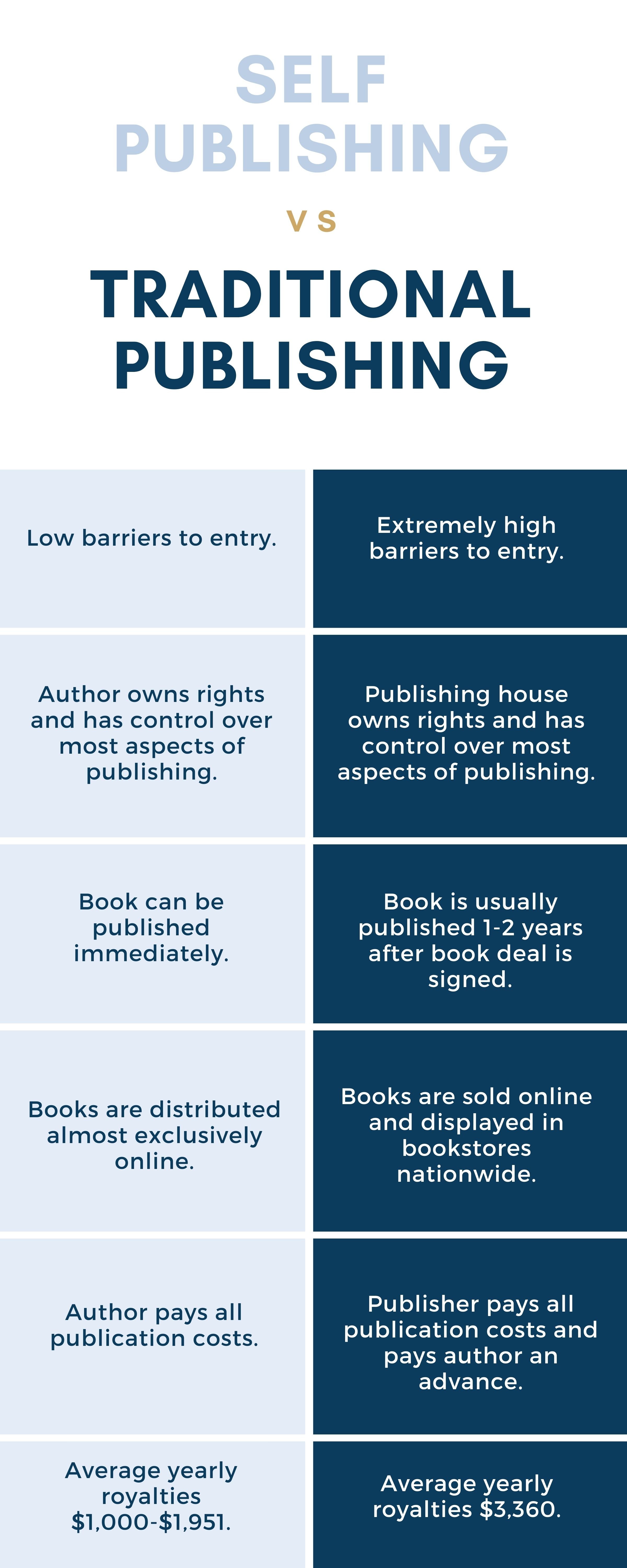Self Publishing vs Traditional Publishing: A Thorough Side-by-Side Analysis
To Self-Publish or Traditionally Publish?
I’m going to cut out all opinion and all hype to be as realistic and straightforward as I can about the ins and outs and the pros and cons of both ways to publish.
It’s maddening that so many articles on this subject are pushing an agenda. Too many self-pub advocates promise overnight riches (if you buy their programs), and too many traditional-pub proponents look down their nose at self-publishing for no good reason.
It’s not that I don’t have opinions. I do, and you can read them in my post Should You Self Publish: Two Strong Opinions. But I think it’s even more valuable to give you as unbiased a breakdown as I can, so you can make the decision for yourself.
Here’s the perspective I’m coming from — I have a traditionally published novel, and I’m thinking about self-publishing an exciting new project I’m still noodling. I’ve helped clients write and edit books they traditionally published, and I’ve helped clients write and edit books they’ve then self published.
If I’m selling anything, it’s that I want you to write the best book you possibly can no matter how you deliver it to readers.
First, How Each Version of Publishing Works
Before I start comparing the two routes to market, I want to break down the basics of how these two very different processes work. If you know this, go ahead and scroll down to the side-by-side comparisons.
How traditional publishing works
You write, revise, and polish the book, and then you pitch literary agents. Your agent then pitches your book to editors at publishing houses.
When a publishing house buys the rights to your book, they pay you an advance on earnings, more commonly just called an advance.
They then set a publication date, usually one to two years in the future, and work with you to edit, copyedit, the proofread the text. They design the cover and interior formatting, take care of the marketing, advertising, publicity, and printing costs, and work with a distributor to start selling it in bookstores.
You would then start earning royalties on every book sold, but only after you’ve earned back the advance they paid you.
How self-publishing works
With self-publishing, you write the book, retain the rights, and take responsibility for everything that happens after.
You may do everything yourself, or you may hire an editor and proofreader, cover designer, marketing company, and/or publicist to take advantage of their expertise and to do a lot of the work for you.
If you want a print copy of the book, you’ll also use a company for that, which could mean print-on-demand or a print run of a certain number of copies. Most authors go with Amazon KDP Print, which is a POD service.
A side-by-side comparison of traditional publishing and self publishing
Barriers to entry
TRADITIONAL PUBLISHING
Extremely high. There’s no useful way to calculate the odds of getting a traditional publishing deal. A Google search will give you sound arguments that the odds are as low as one in a million or as high as 23%. Both are meaningless.
The one in a million stat includes all writers who aspire to traditionally publish a book, which obviously includes a huge number of people who will not put in one iota of the effort required. And the 23% comes from a survey of proficient writers and may be skewed in the opposite direction.
Regardless, landing a book deal is a difficult thing to do.
SELF PUBLISHING
Low. Anyone with enough discipline to finish a book can self-publish. Of course, finishing a book is no easy feat!
Control
TRADITIONAL PUBLISHING
Little to none.
Once you’ve sold the book to a publisher and they own the rights, they’re in control. This doesn’t mean they’re going to edit it into something entirely different. You’d have some recourse against that. But it does mean that they will choose the cover, and the interior design, along with the budget and methods for marketing and advertising. They’ll almost certainly ask for your input on all of the above, and your agent can fight for your opinions to be honored, but ultimately, there are no guarantees you’ll be happy.
SELF PUBLISHING
Almost, but not quite, total control.
Because you retain the rights and you’re paying for everything, you get to make all the pre-publication decisions. You choose the cover and the interior design, make all editing choices, and decide where to publish and sell it.
Pricing is where you won’t have complete control, at least if you’re publishing through Amazon. Although you’ll have more leeway over pricing than with a traditional publishing house, you will have to follow Amazon’s rules. If you want their higher 70% royalty rate, you must sell your book for no less than $2.99 and no more than $9.99. If you’re okay with their 35% royalty rate, you must sell it for no less than $.99 and no more than $200.
Also, if you’re selling the book on your site or elsewhere, you can’t sell it for a lower price than the price listed on Amazon. Thais can get really tricky if you use a a service like Ingram to distribute your book to places like Walmart and Barnes and Noble. Those resellers can lower the price without your knowledge, while still giving you the proper cut, but Amazon won’t like that. They’ll come after you, even though you have about as much control over a 500-billion-dollar company like Walmart as you do the United Nations.
Time to publication
TRADITIONAL PUBLISHING
Typically, from book deal to bookstores is about two years.
SELF PUBLISHING In theory, you could write The End today and have it in readers’ hands tomorrow.
A writer I know recently said she wanted her book to come out within two months to coincide with a national event. If she’s determined to meet that deadline, she has no choice but to self publish.
Distribution
TRADITIONAL PUBLISHING
More or less anywhere books are sold. Just don’t expect to be in airport bookstores until you’re a bestseller! But your book will be sold brick and mortar bookstores throughout the country. If you have a big-five publisher, it will most likely be displayed on the front tables at Barnes & Noble for at least a few weeks.
SELF PUBLISHING
Mainly online
Whether it’s an e-book or a print-on-demand paperback, the vast majority of your sales will be done online.
Although every now and then a really famous personality with a built-in audience gets a self-published book into physical bookstores, I can all but guarantee it’s not going to happen for you. You might sell it on consignment at the store by your house, but you’re not going to have nationwide distribution at independent bookstores and large real-life stores like Barnes & Noble and Target.
Some people will tell you that if your book is distributed by Ingram it can appear in bookstores. It can. Bookstores physically could order your book, but even traditional publishers have sales teams to get bookstores to make orders. Unless a self-published book has is currently selling insane numbers of copies — like Fifty Shades of Grey once did — they’re simply not going to order it.
Besides Amazon, you can sell it yourself in person and on your website, and you can also sell it online through other marketplaces like Gumroad, Apple Books, Google Play, and online versions of Barnes and Noble and some other bookstores.
Let’s Talk Money
Cost
TRADITIONAL PUBLISHING
$0
However, as I mentioned above, it’s very common to hire an editor before pitching agents, and according to the Editorial Freelancer’s Association a middle-of-the-road cost is $50 an hour for 1-5 pages per hour. Some authors also decide to hire an outside publicist to supplement their publisher’s efforts. According to Writer’s Digest, a four month campaign would cost about $5,000-$10,000. Personally, I’ve never met a writer that spent that much, or at least admitted to it. May I should have and my book would have sold more copies. ;-)
SELF PUBLISHING
Next-to-nothing to the sky’s-the-limit.
If you’re going to skip editing and proofing, design your own cover, and put it out there with no marketing, you can self publish for free, though your book probably won’t be readable. If you went all out on editing, formatting, cover design, and marketing, you could spend tens of thousands of dollars. A publicist alone would still charge $5-$10,000. According to Reedsy — a marketplace for freelance designers and editors — most authors spend $2,000-$4,000 to self publish.
Earnings
TRADITIONAL PUBLISHING
According to agent and blogger Rachelle Gardener, “a typical first-timer advance might be anywhere from $5,000 to $15,000 per book.” Because the publisher has taken on all the cost and risk, royalties are then usually 8-15%.
According to the Author’s Guild, when it comes to book-only earnings, the average traditionally published author makes $3,360 per year in royalties. When it comes to the top 10% of earners, the median goes up to $305,000 per year.
SELF PUBLISHING
No one’s going to give you an advance, but because you’ve taken on all the cost and risk, your royalties will be MUCH higher, ranging from 35-70%, depending on the price you’re charging for your book.
According to The Author’s Guild, the average self-published author makes $1,950 per year, and the average romance or romantic suspense author earns $10,050. Romance sells!! At the top end, the highest 10% of earners reached a median of $154,000 a year.
In another survey by The Guardian, the average self-published author earns $1,000 a year, nearly a third made less than $500, and 90% sold less than 100 copies. Why the disparity in these surveys? Perhaps because the 2015 survey is so dated, or perhaps it’s because only the more successful writers are joining the Author’s Guild.
Conclusion
Did the money section kill your buzz? Clearly, no matter which way you publish, how much you earn can be a crap shoot!
Authors make millions with self-published books. Authors make millions with traditional books. People also win the Powerball jackpot. The odds are about the same.
The best and only way to maximize your chance of financial success is to write and publish the highest quality book you can. Check out this post to learn what two steps you need to take first to make sure your book will attract readers.
The other good news is that authors can earn a living in a number of related ways including speaking, podcasting, blogging, teaching, just to name a few.
If it’s all about high earnings for you, there are far more predictable ways to get there — investment banking, anesthesiology, and pharmaceutical sales jump to mind.
Write books because you have a story to tell or something to teach people. If you do that well, no matter how you publish or how much money you make, the rewards will be priceless.
Go tell your story!







![6 Signs You’re Ready to Query Literary Agents [Or Not]](https://images.squarespace-cdn.com/content/v1/554b7160e4b03e55c45d8cdc/1740587740537-1J4XMGD5TQBV2BGKACCA/ready+to+query+literary+agents.jpg)






